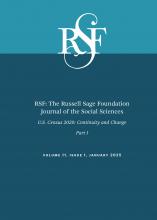Research Article
Open Access
The “Rise” of Multiracials? Examining the Growth in Multiracial Identification in the 2020 U.S. Census
Ilana M. Ventura, René D. Flores
RSF: The Russell Sage Foundation Journal of the Social Sciences January 2025, 11 (1) 44-64; DOI: https://doi.org/10.7758/RSF.2025.11.1.03
Ilana M. Ventura
aResearch methodologist at NORC at the University of Chicago, United States
René D. Flores
bAssociate professor of sociology at the University of Chicago, United States

REFERENCES
- ↵
- Alba, Richard,
- Brenden Beck, and
- Duygu Basaran Sahin
- ↵
- Anders, John,
- Mary E. Campbell,
- Craig Wesley Carpenter, and
- Luna Chandna
- ↵
- Brunsma, David L
- ↵
- Cohn, D’Vera
- ↵
- Corntassel, Jeff
- ↵
- Daily, Donna,
- Patrick Cantwell,
- Karen Battle, and
- David G Waddington
- ↵
- Davenport, Lauren D
- ↵
- Davenport, Lauren D.,
- Shanto Iyengar, and
- Sean J. Westwood
- ↵
- Farley, Reynolds
- ↵
- Flood, Sarah,
- Miriam King,
- Renae Rodgers,
- Steven Ruggles,
- J. Robert Warren, and
- Michael Westberry
- ↵
- Flores, René D.,
- María Vignau Loría, and
- Regina Martínez-Casas
- ↵
- Goldberg, David Theo
- ↵
- Goldberg, David Theo
- ↵
- Gómez, Laura E
- ↵
- Harris, David R., and
- Jeremiah Joseph Sim
- ↵
- Harrison, Roderick
- ↵
- Herman, Melissa
- ↵
- Ho, Arnold K.,
- Jim Sidanius,
- Daniel T. Levin, and
- Mahzarin R. Banaji
- ↵
- Hout, Michael, and
- Joshua R. Goldstein
- ↵
- Jacobson, Matthew Frye
- ↵
- Jones, Nicholas,
- Rachel Marks,
- Roberto Ramirez, and
- Merarys Rios-Vargas
- ↵
- Jones, Nicholas A., and
- Amy Symens Smith
- ↵
- Kiley, Kevin, and
- Stephen Vaisey
- ↵
- Lee, Jennifer, and
- Frank D. Bean
- ↵
- Lichter, Daniel T., and
- Zhenchao Qian
- ↵
- Liebler, Carolyn A.,
- Sonya R. Porter,
- Leticia E. Fernandez,
- James M. Noon, and
- Sharon R. Ennis
- ↵
- Loveman, Mara
- ↵
- Marks, Rachel, and
- Merarys Rios-Vargas
- ↵
- Marx, Anthony W
- ↵
- Menendez, Janin
- ↵
- MIT Election Data and Science Lab
- ↵
- Mora, G. Cristina
- ↵
- ↵
- Nagel, Joane
- ↵
- Nobles, Melissa
- ↵
- Office of Management and Budget (OMB)
- ↵
- Office of Management and Budget (OMB)
- ↵
- Passel, Jeffrey S., and
- Jens Manuel Krogstad
- ↵
- Perlmann, Joel, and
- Mary C. Waters
- ↵
- Prewitt, Kenneth
- ↵
- Pryor, Edward T.,
- Gustave J. Goldmann,
- Michael J. Sheridan, and
- Pamela M. White
- ↵
- Qian, Zhenchao
- ↵
- Qian, Zhenchao, and
- Daniel T. Lichter
- ↵
- Rasinki, Kennith A
- ↵
- Rockquemore, Kerry Ann
- ↵
- Rockquemore, Kerry Ann, and
- David L. Brunsma
- ↵
- Rodriguez, Clara E
- ↵
- Roth, Wendy D
- ↵
- Ruggles, Steven,
- Sarah Flood,
- Matthew Sobek,
- Danika Brockman,
- Grace Cooper,
- Stephanie Richards, and
- Megan Schouwiler
- ↵
- Sáenz, Rogelio,
- Sean-Shong Hwang,
- Benigno E. Aguirre, and
- Robert N. Anderson
- ↵
- Saperstein, Aliya, and
- Andrew M. Penner
- ↵
- Schuman, Howard, and
- Stanley Presser
- ↵
- Skerry, Peter
- ↵
- Skerry, Peter
- ↵
- Tavernise, Sabrina,
- Tariro Mzezewa, and
- Giulia Heyward
- ↵
- Townsend, Sarah S. M.,
- Stephanie A. Fryberg,
- Clara L. Wilkins, and
- Hazel Rose Markus
- ↵
- U.S. Census Bureau
- ↵
- Waters, Mary C
In this issue
The “Rise” of Multiracials? Examining the Growth in Multiracial Identification in the 2020 U.S. Census
Ilana M. Ventura, René D. Flores
RSF: The Russell Sage Foundation Journal of the Social Sciences Jan 2025, 11 (1) 44-64; DOI: 10.7758/RSF.2025.11.1.03
Jump to section
Related Articles
- No related articles found.
Cited By...
- No citing articles found.





